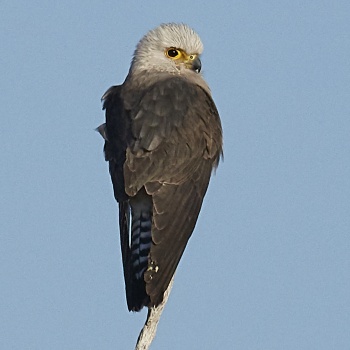KCFoggin-243 (talk | contribs) |
(Imp sizes. Picture placement due to edit button issues. Some extra info. References updated) |
||
| Line 1: | Line 1: | ||
| − | [[Image:Dickinson's_Kestrel.jpg|thumb| | + | [[Image:Dickinson's_Kestrel.jpg|thumb|450px|right|Photo by {{user|GordonH|GordonH}}<br />Pafuri, [[Kruger National Park]], [[South Africa]], April 2009]] |
| − | + | ||
;[[:Category:Falco|Falco]] dickinsoni | ;[[:Category:Falco|Falco]] dickinsoni | ||
==Identification== | ==Identification== | ||
| − | 27-30cm | + | 27-30cm (10½-11¾ in) |
*Dark grey plumage | *Dark grey plumage | ||
*Pale head and rump | *Pale head and rump | ||
| Line 20: | Line 20: | ||
Sub-Saharan [[Africa]]. Southern [[Tanzania]] including Pemba, south to northern [[South Africa]] and west to southern [[Angola]]. Resident. | Sub-Saharan [[Africa]]. Southern [[Tanzania]] including Pemba, south to northern [[South Africa]] and west to southern [[Angola]]. Resident. | ||
==Taxonomy== | ==Taxonomy== | ||
| + | [[Image:Dickinson'sKestrelrafiki.jpg|thumb|350px|right|Photo by {{user|Rafiki|Rafiki}}<br />Pafuri, Moremi, [[Botswana]], July, 2017]] | ||
This is a [[Dictionary_M-O#M|monotypic]] species<sup>[[#References|[1]]]</sup>. | This is a [[Dictionary_M-O#M|monotypic]] species<sup>[[#References|[1]]]</sup>. | ||
==Habitat== | ==Habitat== | ||
| − | Low-lying | + | Low-lying wooded savanna and cultivated land, particularly in floodplains. |
==Behaviour== | ==Behaviour== | ||
====Diet==== | ====Diet==== | ||
| − | The diet | + | The diet consists mainly of small birds, chameleons, grasshoppers, lizards, amphibians, bats, rodents and snakes. |
====Breeding==== | ====Breeding==== | ||
Often nests in a scrape in ''Borassus'' palms. The 1-4 cream eggs, have reddish-brown markings and are incubated by the female for 30 days; the young fledge about 33-35 days later. | Often nests in a scrape in ''Borassus'' palms. The 1-4 cream eggs, have reddish-brown markings and are incubated by the female for 30 days; the young fledge about 33-35 days later. | ||
==References== | ==References== | ||
| − | #{{Ref- | + | #{{Ref-Clements6thAug16}}#Handbook of the Birds of the World Alive (retrieved August 2017) |
| + | #Wikipedia | ||
{{ref}} | {{ref}} | ||
==External Links== | ==External Links== | ||
{{GSearch|Falco+dickinsoni}} | {{GSearch|Falco+dickinsoni}} | ||
[[Category:Birds]] [[Category:Falco]] | [[Category:Birds]] [[Category:Falco]] | ||
Latest revision as of 23:29, 8 August 2017
- Falco dickinsoni
Identification
27-30cm (10½-11¾ in)
- Dark grey plumage
- Pale head and rump
- Grey, narrow black barred tail with broad subterminal band
- Barred underside of flight feathers
- Yellow cere
- Bare yellow eye skin
- Brown iris
- Dark grey bill
Female larger than the male Juvenile
- Grey brown
- Barred flanks
- Green cere and eyering
Distribution
Sub-Saharan Africa. Southern Tanzania including Pemba, south to northern South Africa and west to southern Angola. Resident.
Taxonomy
This is a monotypic species[1].
Habitat
Low-lying wooded savanna and cultivated land, particularly in floodplains.
Behaviour
Diet
The diet consists mainly of small birds, chameleons, grasshoppers, lizards, amphibians, bats, rodents and snakes.
Breeding
Often nests in a scrape in Borassus palms. The 1-4 cream eggs, have reddish-brown markings and are incubated by the female for 30 days; the young fledge about 33-35 days later.
References
- Clements, J. F., T. S. Schulenberg, M. J. Iliff, D. Roberson, T. A. Fredericks, B. L. Sullivan, and C. L. Wood. 2016. The eBird/Clements checklist of birds of the world: v2016, with updates to August 2016. Downloaded from http://www.birds.cornell.edu/clementschecklist/download/
- Handbook of the Birds of the World Alive (retrieved August 2017)
- Wikipedia
Recommended Citation
- BirdForum Opus contributors. (2024) Dickinson's Kestrel. In: BirdForum, the forum for wild birds and birding. Retrieved 26 April 2024 from https://www.birdforum.net/opus/Dickinson%27s_Kestrel





